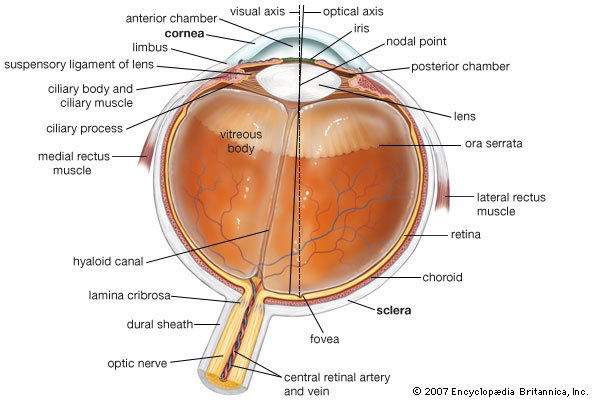Types of Vision and different eye defects
Types of vision
(i) Binocular Vision :
Man has binocular vision in which both the eyes are focussed on the same object but from slightly different angles. The visual fields of both eyes overlap and the foveae of both are focused on the same object. This provides depth to the images, i.e., gives stereoscopic or 3D effect and enables man to judge distances correctly.

Checkout more info here: ear model labeled anatomy
(ii) Vision in other animals :
Primates and predatory animals, such as owl and cat, have binocular vision.In some animals, such as rabbit, birds, each eye is focussed on a separate object. This is termed monocular vision.
(iii) Colour vision :
It is the ability of some animals to detect colours in an object. Humans, apes, monkeys, and most fishes, amphibians, reptiles and birdss have strong colour vision. The insects and crayfish also have colour vision. In vertebrates, colour vision results from the activity of cone cells. Most domestic and nocturnal mammals and sharks lack colour vision. They probably see objects in shades of grey (monochrome vision).
(iv) Nocturnal and Diurnal vision :
Man has both day vision and night vision as he has both rods and cones in considerable numbers in the retina. Most birds have only day vision as their retina contains mainly cones. Owls have much better night vision than day vision for they possess a large number of rods and few cones in their retina.
(2) Range of vision :
The visible range of spectrum varies in animals. Bees, ants, spiders and goldfish can see ultraviolet light, which is invisible to man.
(3) Eye movement :
In eye orbit, eyeball remain attached with 6 extrinsic muscles.
Out of six, first four are rectus and last two are oblique muscles.
(1) Anterior rectus or Internal ractus
(2) Posterior rectus or External ractus
(3) Inferior rectus
(4) Superior rectus
(5) Inferior oblique muscle
(6) Superior oblique muscle
Types of Vision and different eye defects.
Types of Vision and different eye defects.
Eye Defects
(a) Myopia
(i) Also known as near sightness.
(ii) Short sightness.
(iii) Near object is clear. Far object is not clear.
(iv) Eyeball become longer.
(v) Image is formed before retina. Can be removed by concave lens.
Types of Vision and different eye defects.
(b) Hypermetropia
(i) Also known as hypermetropia or long sightness.
(ii) Far sightness.
(iii) Far object is clear, near object is not clear.
(iv) Eye ball become short.
(v) Image is formed behind the retina.
(vi) Can be removed by convex lens or lens convient.
(c) Astigmatism
(i) Curvature of cornea become irregular and image is not clearly form.
(ii) Can be removed by cylindrical lens.
(d) Cataract
(i) It is due to defective protein metabolism.
(ii) During this lens or cornea sometime both become opaque.
(iii) Operation is needed.
(e) Glaucoma
(i) It is due to increase in intraocular pressure in aqueous chamber.
(ii) Operation is needed at early stage due to blockage of schlemm’s canal.
(f) Trachoma
(i) It is increased in redness of eye and more secretion of watery fluid.
(ii) It is due to infection of bacteria, chlamidia trachamastis.
(iii) Due to this follicles may form in conjunctiva.
(g) Xeropthalmia
(i) It is due to deficiency of vitamin A. (A2)
(ii) During this conjunctiva or cornea becomes keratinized.
(iii) It may lead to blindness.
(h) Strabismus
(i) In this type eyeball remain in some what in bended position.
(ii) It is due to long extra ocular muscles during development of eye.
(iii) Operation is needed at early stage.
(iv) Also associated with squint.
(i) Presbiopia
(i) During this power of accommodation of lens decreases due to age factor and defected metabolism.
(ii) Also known as age sightness.
(iii) Can be removed by bifocal lens.
Click here to know more about: autonomic nervous system function
(j) Photophobia : No clear image in bright light.
(k) Emmetropia : Normal vision.
